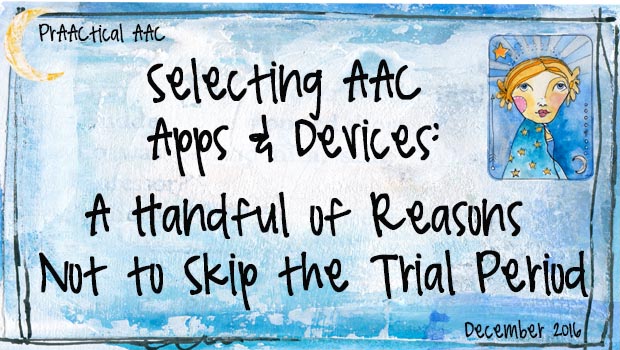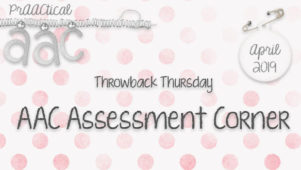Selecting AAC Apps & Devices: A Handful of Reasons Not to Skip the Trial Period

Would you buy a car without test-driving it first? Most of us would not, and for very good reasons. The car might have all the features we need, come with strong reviews from respected organizations, and look great, but there’s other important data that we can only get from driving it. How does the car feel when you’re in the driver’s seat? We might rule it out if the blind spots were too big, the seat was uncomfortable, or the handling didn’t meet our needs. That information can only come from actually trying it out. Prevailing wisdom suggests that a similar process is a critical step in selecting an AAC device or app.
There are a lot of things that make it tempting to skip this step. It’s difficult to arrange for trials with multiple devices and apps. It takes a lot of time. We have to train them on each AAC option that we’re trying out. And, most importantly, we hate the thought of stopping a trial when someone has been successful in order to move onto a different device/app and conduct another trial. There are some times when the trial period is extremely limited, but very few times when we could advocate skipping trials altogether.
Is your team tempted to skip this step? Here are some things to consider.
- AAC use in functional settings may reveal problems that are not apparent when the SGD/app is tested out in clinical or educational settings. Think of all the differences in those environments that impact AAC use, such as the physical characteristics which may impact someone’s ability to see the screen or hear the voice output, and the distractions that may compete for the learner’s attention. These things matter and it is hard to get a read on how the AAC functions in real-world settings without using it there.
- The funding agency may require this kind of data.
- It’s part of practice-based evidence (PBE) and gives us a systematic way of collecting data to compare how well a client does with one device/app versus another one with the same features. This allows us to make decisions based on data rather than anecdote. By considering what kind of data will help the team make an informed decision about how to proceed, we can develop a plan to gather information that is meaningful for a particular AAC client and use that in our decision-making.
- In some situations, the period of trial use gives us a head-start. By using the trial device at home, in school, and/or in therapy, each of the players in those environments gets first-hand experience with what it will take to support the AAC user with that particular device/app. Often, it is more challenging than they originally thought it would be and this experience prepares them for what will come once the device arrives.
Having a systematic approach to trialing AAC devices/apps can help us avoid issues with implementation and functional use for whatever tool ultimately is selected. As the old adage goes, “It’s better to do it right, than to do it quickly.”
Have questions on what the trial period might look like? Stay tuned. We’ll be addressing that in a future post.
Filed under: Featured Posts, PrAACtical Thinking
Tagged With: app selection, assessment, SGD selection, trial use
This post was written by Carole Zangari





2 Comments
Carole, can you provide any resources (AAC related or even related to learning skills in general) that suggest the length of time needed/recommended for a trial period (I tend to recommend a minimum of one month).
Thank you!
Carolyn, I find that it varies widely depending on the individual situation. Here are some thoughts on it: http://praacticalaac.org/praactical/aac-apps-and-devices-thoughts-on-conducting-aac-trials/. For some, a month is too long, and for others it is way too short. The post that I linked to has some ideas for things to consider in making that decision. It’s a tough one!